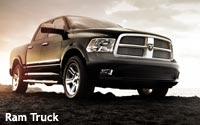automotive
Q&A: Hunter Says There's No 'D' In Ram
- by Karl Greenberg , March 20, 2012
 While GM and Ford have been reducing their brand portfolios to four and two, respectively. Chrysler Group has been enlarging its. The automaker, once a
three-brand manufacturer, has doubled the count since being under the aegis of Fiat S.p.A. Now there's Chrysler, Jeep, Dodge, Fiat, Ram and SRT (the latter is a performance marque that the company
this year is turning into its own brand.)
While GM and Ford have been reducing their brand portfolios to four and two, respectively. Chrysler Group has been enlarging its. The automaker, once a
three-brand manufacturer, has doubled the count since being under the aegis of Fiat S.p.A. Now there's Chrysler, Jeep, Dodge, Fiat, Ram and SRT (the latter is a performance marque that the company
this year is turning into its own brand.)
Marissa Hunter, head of advertising for the Ram truck brand, joined Chrysler in 2009, before it parted ways with Dodge. Though new to the company, she was part of that process. This year, Hunter is involved in an array of marketing efforts from country music to equestrian event sponsorship and a new ad campaign, "Giant."
In this two-parter, Hunter tells Marketing Daily how the automaker is bolstering Ram's equity as its own brand. It's not an easy task. Even as we chatted, I frequently found myself saying "Dodge" by accident, and she conceded that I'm not alone. "It's a learning process."
advertisement
advertisement
Q: Ram's first big campaign since the split from Dodge was last year's "Code of the West" that launched the "Guts. Glory. Ram" tag line. I recall that the campaign used an Old West theme to differentiate the Ram brand by talking about vehicle features. Was it to set up what the brand is supposed to represent?
A: The whole approach was to introduce what the brand stands for using that initial 60-second spot which talked very much about the "code": taking care of people, doing the right things, honoring your promises and commitments. That a handshake was a deal. We used that concept as a way to send a message to consumers that this is how the Ram brand operates. That we have a responsibility to our customers, and that we are going to build our products to their expectations, and we are going to deliver on our promises. Using that parallel of the Old West as a breakthrough, as a fresh unique creative platform, got that message out there. Following that, we did focus 30-second executions on what our competitive advantages are.
It was also the first time we did a dedicated message around the Power Wagon, an incredibly capable off-road pickup, and that's continuing to air on TV.
Q: How about the tag line, "Guts. Glory. Ram?
A: We arrived at that through an extensive study about where we were, how far we've come and where do we want to go. We got there because it's the idea that we are doing the right things for the right reasons as a brand -- and have the internal guts and fortitude to make the decisions that give consumers the glory. It is a theme line that will continue in campaigns we release going forward.
Q: Why was the separation from Dodge the right move?
A: As an independent brand, there are indicators we are succeeding. We have made significant inroads with sales and share. There are indicators we are also making inroads -- significant improvements -- in terms of ALG residual value analysis. As a stand-alone, and evaluated as such, the data points are moving north.
Q: But what about from a marketing standpoint?
A: We have identified a series of key customer targets -- lifestyle groups and vocational groups -- we want to talk to and a very specific way with very specific insights in terms of how we know they use trucks. When we were bundled and under one halo brand that is trying to market cars, SUVs, minivans and pickup trucks, the ability to have a very unique voice and that stronger point of view in light of the truck buyer's demands was more difficult. Now that we are truly a truck brand, we can talk to people we know really drive trucks in a voice that we know relates to them and more directly connects to them.
Q: But Ram has marketed around country music under the Dodge brand ...
A: There is something very deep in the connection between country music, American values, and full-sized pickup trucks. So we did some of that before, but I think what's easier strategically now is that there are fewer influencers, if you will. We don't have to worry about talking to someone who might be in the market for some other vehicle in the portfolio. The consideration of how the message might affect all of the audience is more focused now. Because “all of the audience” means truck buyers.


